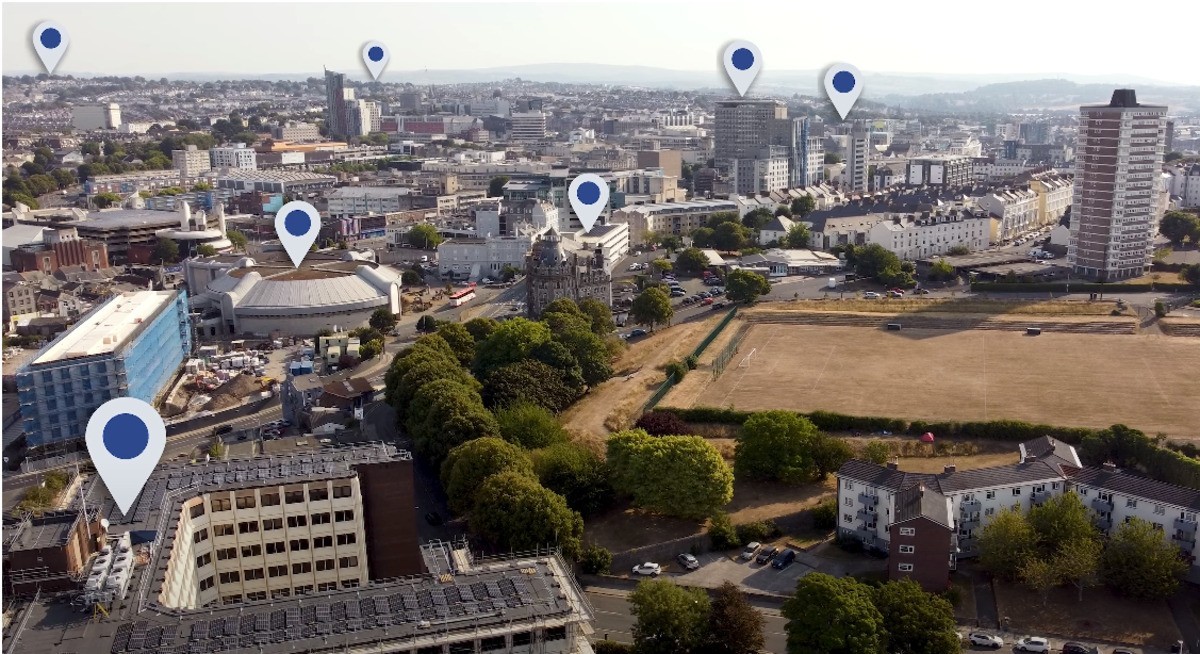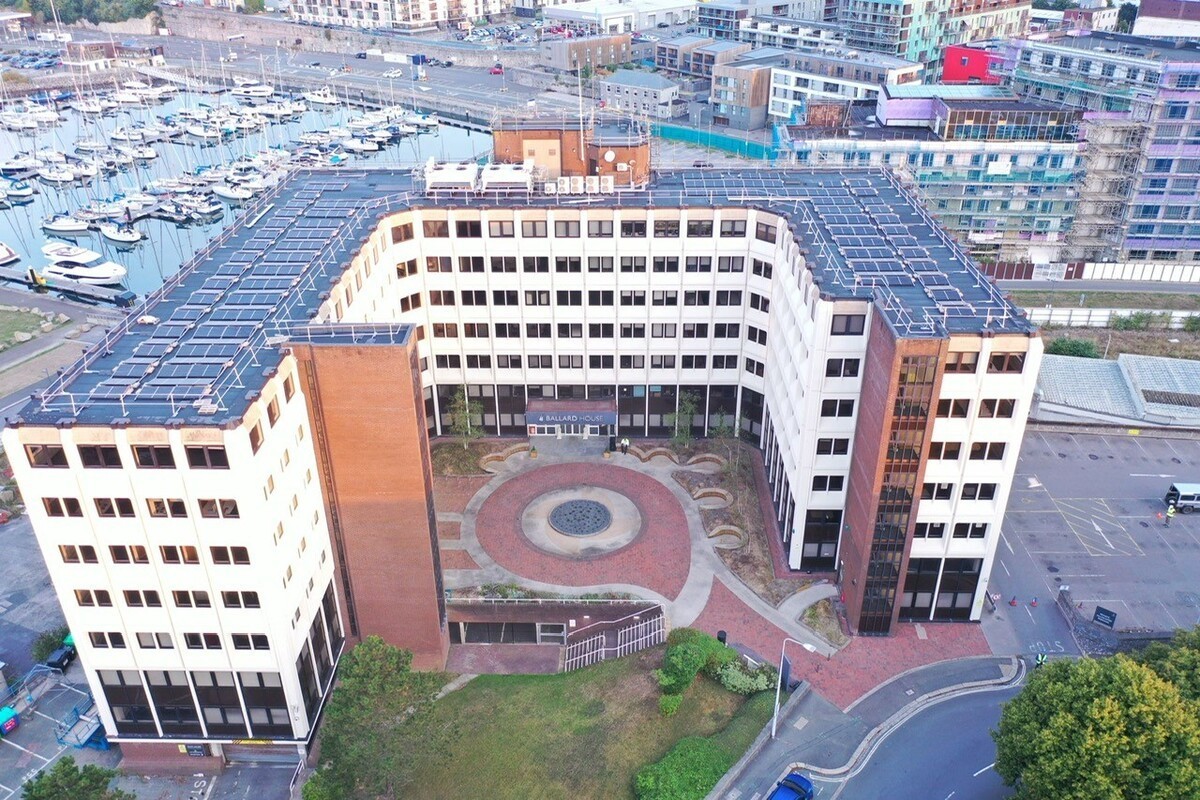The 5th generation heating and cooling grid of Plymouth!
Last modified by the author on 23/03/2023 - 11:43
- Address 1 - street : W Hoe Rd 01752 PLYMOUTH, United Kingdom
- CO2 Impact : 816t / annum
-
8 500 000 €
- Builder
Vital Energi / SunGift Solar/ WJ Groundwater
This project won a mention for the Grand Prize for Sustainable Infrastructure at the national level of the Green Solutions Awards 2022-2023 in a tie with the 5th generation heating and cooling network in Glasgow; the Sustainable Infrastructure Grand Prize and the competition Grand Prize at the international level.
Plymouth City Council (PCC) has taken a significant step towards protecting the environment by declaring a climate emergency and committing to carbon neutrality by 2030, ahead of the national 2050 targets. PCC has created a Climate Emergency Action Plan and Corporate Carbon Reduction Plan to address its own carbon footprint and work with other partners in the city to achieve its goal, particularly in regards to heat grids.
The D2Grids pilot project is building on the groundwork laid by the preceding HeatNet Interreg NWE project. The project aimed to assess heating and cooling demands, locate renewable heat sources, but also led to the design of a 5GDHC grid. The HeatNet project, promoting 4th generation of district heating and cooling grids also resulted in the construction of infrastructure in Millbay and the drilling of test wells into the principal aquifer in the underlying limestone.
The D2Grids pilot has two main objectives, one is to expand the heat grid infrastructure in the Civic Centre cluster to provide low carbon heat to public buildings such as 144 residential units, a commercial area, and a theatre. The other one is to supply social residential dwellings, a hotel, office block, and events arena in Millbay with zero carbon heating and cooling, providing a comfortable and affordable solution.
Renewable energy will be sourced from a combination of ground source, marine water, and air source heat pumps, both centralized and decentralized. The closed energy loops ensure that waste is minimized, with the only waste being cooler seawater, which is returned to the sea.
In figures:
- 1 800 m of network running
- 50 000 m² of total surface served
- 2 400 kW of heating capacity
- 1 400 kW of cooling capacity
- A total of 3 800 MWh of heating and cooling annual supply
Progress Status
In progress
Data Reliability
Self-declared
Website Enterprise / Infrastructure
https://www.plymouth.gov.uk/district-energySustainable Development
Testimony / Feedback
"It will be a very elegant heating & cooling solution. It will provide cheap, low-carbon heat to homes and businesses across the city. The only waste product is cool seawater going back to the sea, and in an overheating planet, a cool discharge is a good thing."
David BIRKS, Hydrogeologist & Geothermal energy specialist
Governance
- Plymouth City Council is managing project and owning the grid
- Vital Energi is the installer of the heat pumps, the heating and cooling grid, and the secondary system changes and integration.
- SunGift Solar is supplying the solar installation and storage
- WJ Groundwater is testing the well yields
Plymouth City Council
Local Authority
Vital Energi / SunGift Solar/ WJ Groundwater
Construction Industry
Public
Sustainable Solutions
- Urban project governance
- Infrastructure
- Climate adaptation
- Renewable energies
- SmartGrids

5GDHC Grids
The 5 principles of 5GDHC
5GDHC grids are smart energy networks based on a local low temperature loop and decentralized production from local renewable energies. This loop allows the exchange of energy between buildings thanks to heat pumps located on the users' premises.
In order to ensure a flexible and resilient energy network to meet current and future needs, a 5th generation heating and cooling system (5GDHC) is established on the following five principles
Closing the energy loop
The first principle of 5GDHC is to avoid wasting energy in the system. A 5th generation grid differs from other heat and cooling grids in its ability to exchange energy with other connected consumers/customers: it is a circular thermal network. The network is designed as a closed loop reusing energy as much as possible: the heated buildings provide cold to the system, while the cooled buildings transmit their excess heat to the network.
The key factor in the 5GDHC approach is the optimal reuse of return flows at different spatial and temporal scales. Energy storage is used to manage the temporal imbalance between supply and demand within the system on a daily, but also seasonal basis.
For example, heat pumps in green buildings to generate the required temperatures. These heat pumps use outdoor air, surface water or soil. On the one hand, this requires investments in source facilities that also need space, which could be an obstacle. On the other hand, some of the energy produced is lost to the surrounding environment. In 5GDHC grids, the back end of these heat pumps is connected to the grid and thus the return flow of energy is retained in the circuit.
This first principle of 5GDHC is implemented in a stepwise approach, exchanging energy first within a building or block, then at the neighborhood level, and finally at the city level. Further optimization of the grid would also be possible through optimized territorial planning.
Using low-grade sources for low-grade demand
Energy sources can be classified according to their applicability. One of the foundations of 5GDHC is the observation of heat and cold demand levels, in order to bring only the necessary amount of energy into the network. A 5GDHC system does not need many high-temperature sources to meet most of its heating and cooling needs. This means that available low-temperature energy streams (such as shallow geothermal, industrial discharge, waste-to-energy, cooling process waste energy, wastewater, etc.) are prioritized when any additional heating or cooling not satisfied by the exchange must be provided to the system.
In order to optimize 5GDHC, a prioritization of the types of input energy to be used was created. First, thermal energy exchanged between users will be used. Next, ambient temperature thermal sources as well as renewable sources with temperatures above the typical "hot" grid temperature. The last energy source in the ranking is thus fossil fuels.
The second principle of 5th generation district heating is therefore to match the available low temperature sources with the demand. The need for high-temperature energy is then reduced, and can then be covered 100% by renewable energies such as deep geothermal, wind, solar, hydro and biomass.
Decentralized & demand-driven energy supply
Traditional energy systems are centralized and circulate a large amount of energy that is never used.
In contrast, 5GDHC systems are "demand-driven," meaning that they only begin to produce and circulate energy when there is demand on the grid. This saves energy: it is produced only when and where it is needed. The system can simultaneously provide heating and cooling services at different temperatures and to different customers by adapting to demand.
In practice, 5GHDC enables a shift from a highly centralized energy system to a decentralized, intelligent grid of small facilities close to the end user.
An integrated approach to energy flows
Many energy systems contain siloed incentives: they do not optimize needs across systems and sectors. For example, a building owner powered by electricity that induces high peaks on the power grid may want to warm up in the morning after a nightly cutback. The use of thermal mass and thermal storage may require additional investment for the building but provide significant savings on the electrical grid. The goal of 5GDHC is to maximize the efficiency of energy delivery and use. This is made possible by an integrated approach to all other energy flows in a given territory (power grids, transport, industry, agriculture, etc.).
Indeed, huge losses in some sectors can be deployed to serve others. Large power plants that waste large amounts of cooling energy at room temperature could cover the heating demand of other buildings. Vehicles in the transportation sector also have low efficiency, losing a lot of heat, and new technologies, such as hydrogen conversion, have high heat losses. Integrating these different sectors can result in significant savings on the total energy balance.
In addition to energy savings, integrating a 5GDHC grid with an electric grid will help balance the grid and increase its flexibility. This will create smaller, more efficient energy infrastructures, requiring less equipment and operating energy. The system, with lower peak capacities, will also require less overall investment in infrastructure (pipelines, pumps, heat pumps, etc.) and reduce the capacity demanded by the power grid.
Priority to local and sustainable sources
This last principle of district heating and cooling grids is a matter of common sense: giving priority to what can be supplied locally rather than to distant thermal sources.
This priority to local sources has first of all an environmental and energy sobriety advantage: giving priority to local sources limits the energy losses linked to transport. But it is also an important economic advantage, as it encourages investment in local energy production, to the benefit of the territory in which the grid is located.
Photo credit
Plymouth City Council












